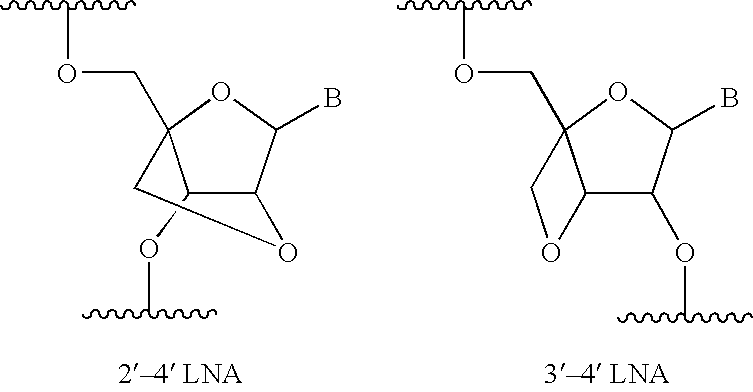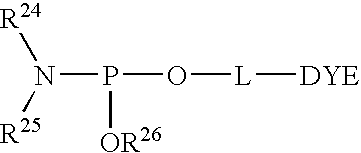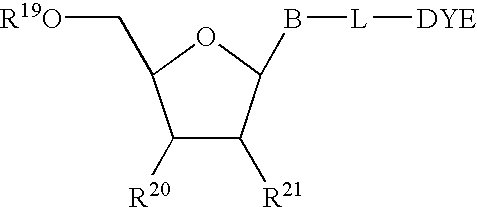Asynchronous primed PCR
- Summary
- Abstract
- Description
- Claims
- Application Information
AI Technical Summary
Benefits of technology
Problems solved by technology
Method used
Image
Examples
example 1
[0165] Melting Temperature Tm Determination of Primers and PNA FRET Probes
[0166] Melting temperature (Tm) measurements of PNA FRET probes were performed on either a Lambda 14 spectrophotometer (Perkin-Elmer, Norwalk, Conn.) equipped with a Peltier temperature controller. Temperature ramp rates were 1.degree. C. / min with continuous monitoring at 260 .mu.m. Tm values were calculated using the maximum values of the first derivative curves of the A260 vs. temperature plots using software provided by the manufacturer. Tm determinations were conducted in buffer containing 10 mM sodium phosphate and 100 mM sodium chloride. Prior to each Tm measurement, each strand of the various DNA templates and PNA probes were quantified using UV spectroscopy and diluted into the final melting buffer at a final concentration of 1 .mu.M. The final optical density range was between 0.2 and 0.8 OD (optical density units) at 260 nm. The samples were "pre-melted" by heating to 90.degree. C. for 5 min and allo...
example 2
[0167] PNA FRET Probe Binding Kinetics to ss DNA and ds DNA (FIG. 6)
[0168] The kinetics of hybridization of a FRET PNA probe to ss and ds DNA was measured (FIG. 6). When the probe is unbound to target, or below the Tm of the probe in the presence of target, the fluorescent dye and the quencher are in an averaged conformation that allows essentially complete quenching of the fluorescent dye (FIG. 5). When the probe is hybridized to target, the fluorescent dye and quencher are spatially separated and an increase in fluorescence may be measured due to loss of quenching. Measurement of the fluorescence intensity of a 16 nt PNA FRET probe (SEQ ID NO: 1) gave a baseline of fluorescence. The control experiment contains only PNA probe and no target (FIG. 6, top). Quenching is virtually complete throughout the temperature expanse. A mixture of the probe and ds target DNA was held at 95.degree. C. ds DNA was formed by annealing 68 nt (SEQ ID NO:2) and 74 nt complement (SEQ ID NO:3) to form a ...
example 3
[0171] Comparison of Asynchronous, Traditional, and Asymmetric PCR Thermal Cycling Protocols (FIGS. 4a and 4b)
[0172] An asynchronous thermal cycling protocol was directly compared with a traditional thermal cycling protocol. PCR reactions were conducted by independently varying the following conditions: (i) asynchronous and traditional (single annealing and single extension steps) thermal cycling protocols; (ii) Tm of the primers; and (iii) concentration of the primers. Other conditions were held constant. Target DNA was amplified with three combinations of forward and reverse primers.
[0173] The cycle for asynchronous PCR (A-PCR) is outlined in FIG. 4a where the primers are designed so that the Tm values are approximately 15 degrees apart. In the first half of the amplification cycle, the high Tm primer is annealing to the target and then extended fully. Thereafter the temperature is lowered, e.g. 52.degree. C., and the fluorescence is measured at this part of the cycle. In this par...
PUM
| Property | Measurement | Unit |
|---|---|---|
| Temperature | aaaaa | aaaaa |
| Angle | aaaaa | aaaaa |
| Angle | aaaaa | aaaaa |
Abstract
Description
Claims
Application Information
 Login to View More
Login to View More - R&D
- Intellectual Property
- Life Sciences
- Materials
- Tech Scout
- Unparalleled Data Quality
- Higher Quality Content
- 60% Fewer Hallucinations
Browse by: Latest US Patents, China's latest patents, Technical Efficacy Thesaurus, Application Domain, Technology Topic, Popular Technical Reports.
© 2025 PatSnap. All rights reserved.Legal|Privacy policy|Modern Slavery Act Transparency Statement|Sitemap|About US| Contact US: help@patsnap.com



